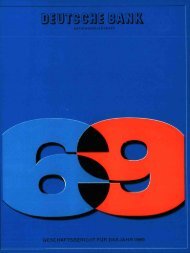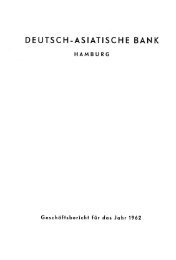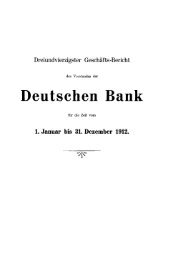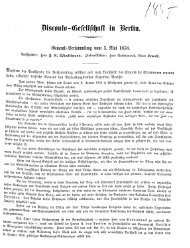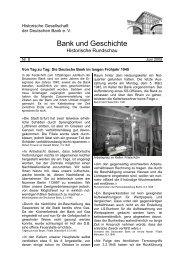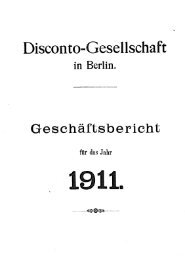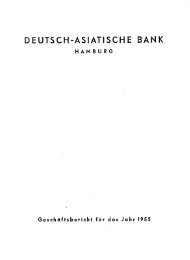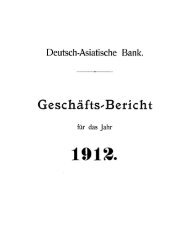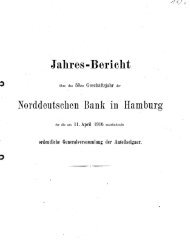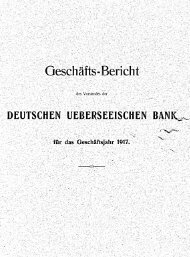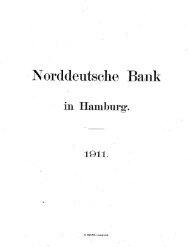Deutsche Bank AG - Historische Gesellschaft der Deutschen Bank e.V.
Deutsche Bank AG - Historische Gesellschaft der Deutschen Bank e.V.
Deutsche Bank AG - Historische Gesellschaft der Deutschen Bank e.V.
Create successful ePaper yourself
Turn your PDF publications into a flip-book with our unique Google optimized e-Paper software.
General Economic Situation<br />
Sustained growth of the world economy<br />
In 1989, the seventh year of the current upswing,<br />
the world economy continued to expand at a notable<br />
pace. GNP growth in the OECD countries was<br />
stronger than expected at approximately 3.5'16<br />
though not as marked as in the previous year (+4.3%).<br />
The rise in the number of employed persons was<br />
maintained across a broad front. In the OECD region<br />
another roughly 6 million jobs were created in 1989;<br />
the unemployment rate declined from 7% to C. 6.5%.<br />
On average, prices climbed by just un<strong>der</strong> 5% (1988:<br />
3.8%). Inflationary risks stem mainly from wage cost<br />
pressure.<br />
Expanding world trade<br />
World trade expanded quickly in 1989; at 7 to8% in<br />
real terms the growth was not much lower than in the<br />
previous year. Here, the growing integration of Asia's<br />
young industrial nations into the world economy was<br />
a contributory factor. Thus, after strong growth in the<br />
three previous years (by an average of 20%). the<br />
foreign trade of Hong Kong, Singapore, South Korea<br />
and Taiwan together improved again by about 10% in<br />
real terms. The external economic imbalances of the<br />
main industrial regions - the U.S.A., Japan and Europe<br />
- continued to decrease in 1989.<br />
Fe<strong>der</strong>al Republic of Germany:<br />
strongest growth in the '80s<br />
The upturn in the Fe<strong>der</strong>al Republic of Germany,<br />
now un<strong>der</strong>way since 1983, proceeded at an increased<br />
Pace in 1989.The4%growth in real GNP was<br />
the highest in ten years. The number of employed<br />
persons rose by 344,000 to a new post-war high of<br />
27.65 million. Despite the arrival of 721,000 East Germans<br />
and other ethnic Germans in the Fe<strong>der</strong>al Republic<br />
of Germany, the number of unemployed declined<br />
by 204,000. The average annual inflation rate<br />
climbed to 2.8%. For the first time since 1974, the<br />
Fe<strong>der</strong>al budget (incl. social security) recorded a sur-<br />
plus (DM 5.6 bn.).<br />
Dynamic exports and capital spending<br />
Exports and capital spending were the key factors<br />
in the strong GNP growth of the Fe<strong>der</strong>al Republic of<br />
Germany in 1989. Exports grew by 10.8% in real<br />
terms; capital investment in machinery and equipment<br />
climbed by9.1%, and in buildings by5.2%. However,<br />
private consumption increased by only 1.6% in<br />
real terms, whilst public consumption even declined<br />
by 0.8%.<br />
Newcomers ease bottlenecks on the labour market<br />
The widespread shortage of suitable labour despite<br />
persistent high unemployment was alleviated in<br />
the Fe<strong>der</strong>al Republic in 1989 by the inflow of East<br />
Germans and other ethnic Germans. Out of an estimated<br />
450,000 newcomers seeking employment,<br />
about 200,000 found jobs. The availability of this<br />
group of people to take on vacant positions which<br />
would otherwise not have been filled, or at least not<br />
as quickly, facilitated higher overall production in<br />
1989.<br />
lncreasingly restrictive monetary policy<br />
Reacting to the strong economic dynamism and<br />
related fears of inflation, the Bundesbank further<br />
tightened its monetary policy. Key interest rates were<br />
increased in four Stages by a total of 2% percentage<br />
points to 6% (discount rate) and 8% (Lombard rate).<br />
There was a marked fall in the Pace of money supply<br />
growth over the year. With an expansion rate of 4.7%<br />
the monetary target of "approximately 5%" was attained.<br />
One of the effects of the tighter Bundesbank<br />
policy was the inversion of the interest rate structure<br />
on the money and capital markets. At year's end,



